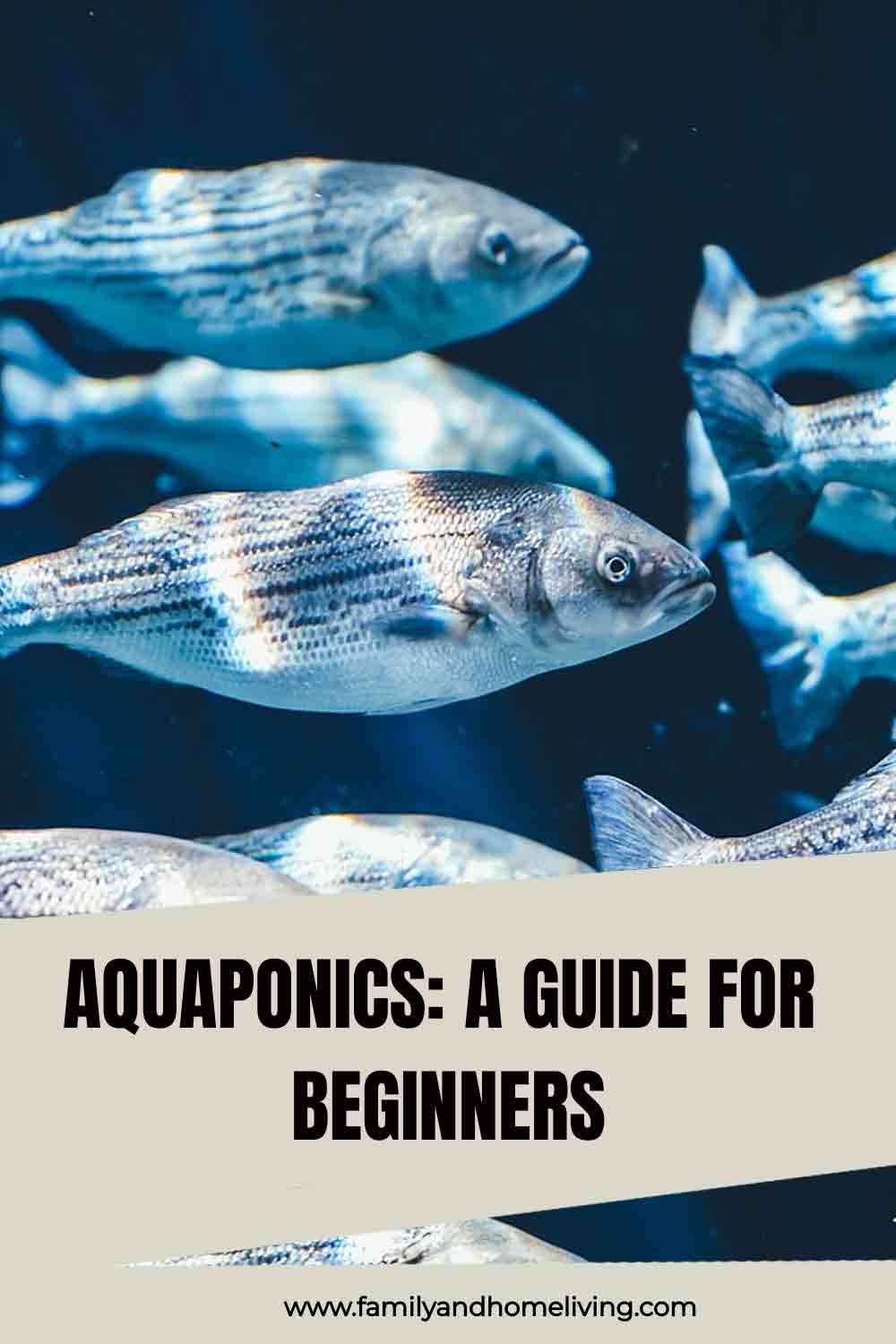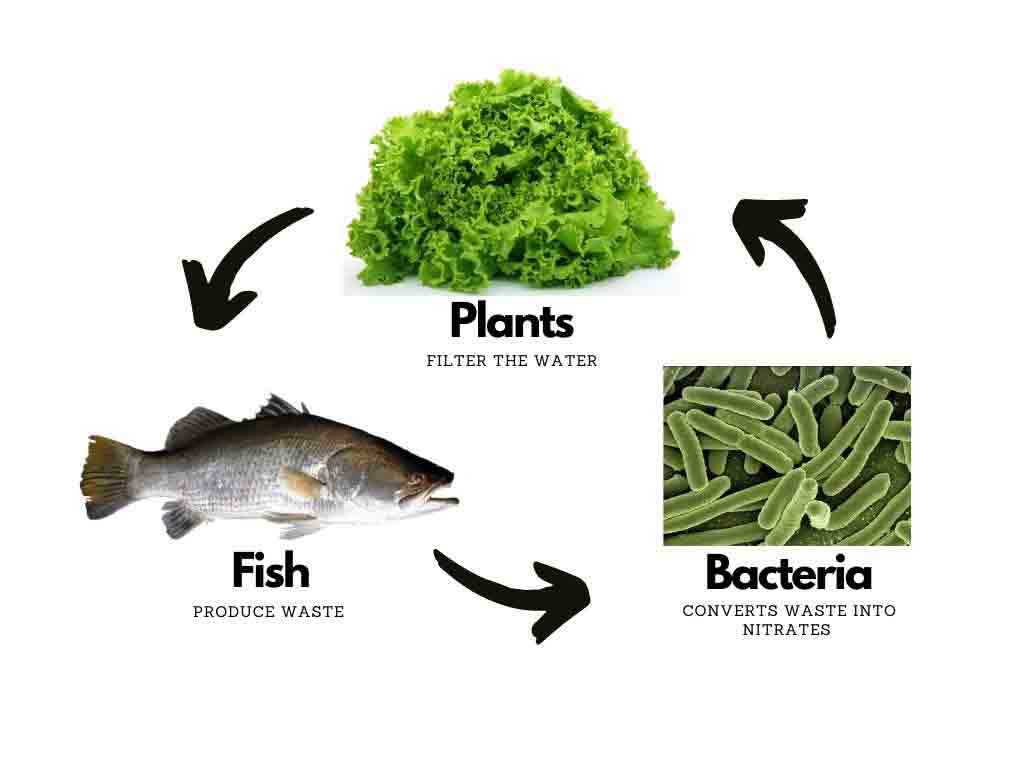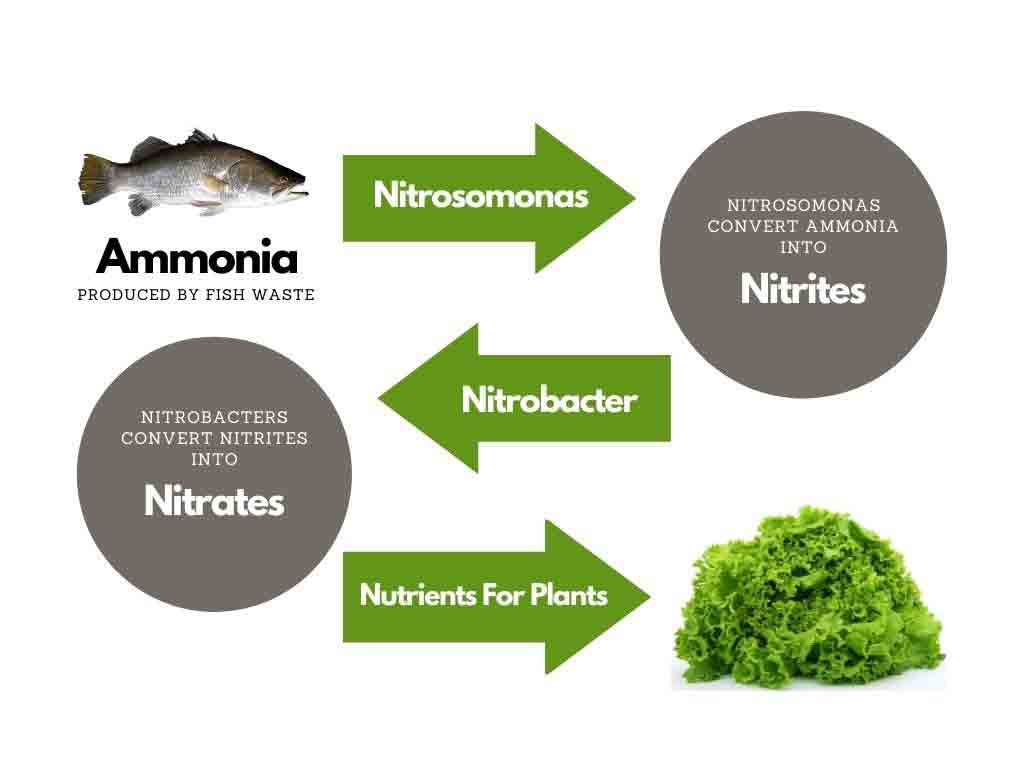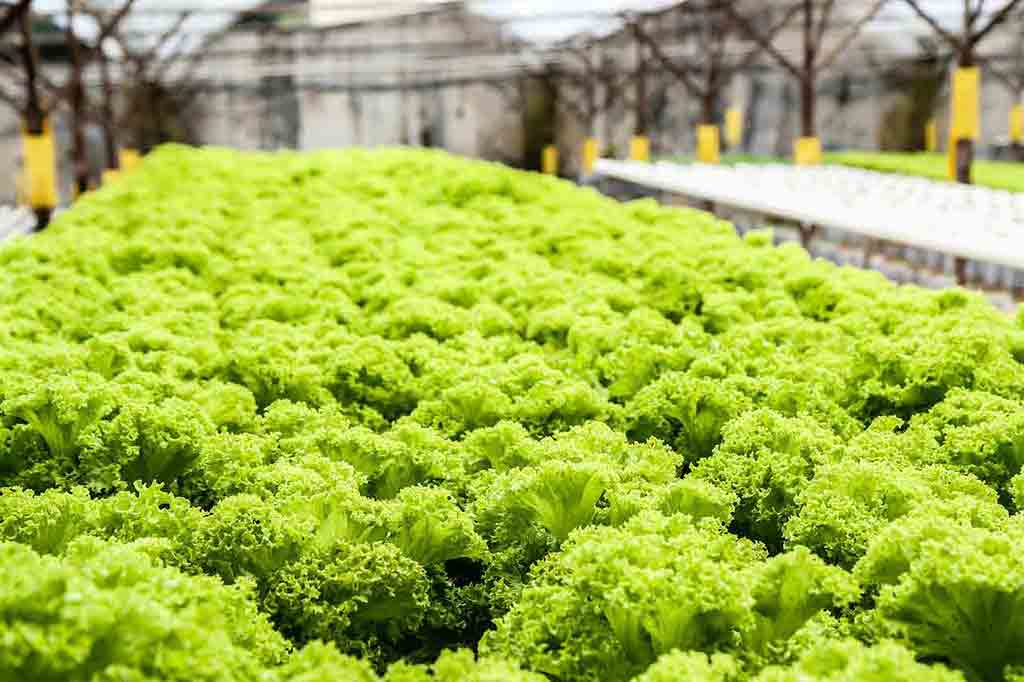This post may contain affiliate links which means we might earn a small commission if you decide to make a purchase through them (at no extra cost to you). Need more info? Click Here
Imagine if you will, 100% organic veggies and fish grown in your very own DIY home aquaponics garden. Veggies grown without bending, digging or heavy lifting! Vegetables grown without commercial fertilizers or soil cultivation, without constant watering, weeding or pests. Now imagine that those vegetables are not only rich in color and taste but are also produced in a small home aquaponic garden that uses 90% less water and produces way more organic food than a normal garden!
Imagine fish of the best quality grown and reared in your own DIY aquaponics system – fish farming that is sustainable and eco-friendly! Now imagine that your crops can be grown all year round and won’t be limited by the growing seasons or the weather. Imagine being able to generate two incomes from one efficient system if you are a backyard farmer and you work from home!
Imagine no more, these are just some of the benefits of small aquaponics for backyard farmers, hobbyists and gardeners who want a natural, sustainable way of providing food security and organic produce for their families. But, what is aquaponics and how does aquaponics work?
- What Is Aquaponics?
- How Does Aquaponics Work?
- How Does Aquaponics Work Step By Step?
- The Aquaponics Nitrogen Cycle
- Does Aquaponic Food Taste Different?
- Why Do Aquaponic Foods Taste Different?
- Do Aquaponic Plants Taste Fishy?
- Can You Eat The Fish From Aquaponics?
- What Are The Best Fish For Aquaponics?
- What Can I Grow In Aquaponics?
- Are Aquaponic Vegetables Healthy?
- Aquaponics Vs Traditional Farming And Gardening
- Aquaponics Books
- Conclusion
What Is Aquaponics?
Aquaponics is the combination of two food production farming methods – Aquaculture and Hydroponics.
Aquaculture is simply the farming of fish in a controlled environment and hydroponics is a farming method where you grow plants, without soil, in nutrient-rich water. So, in a nutshell, aquaponics is an environmentally friendly way of growing and farming plants in the same water that you are fish farming – the perfect solution for backyard farmers who want to provide food security for their families! But, how does aquaponics work?
If this aquaponics article is helpful, please consider pinning it 🙂

How Does Aquaponics Work?
On their own, aquaculture and hydroponics can create a large amount of wastewater – about 10% to 20% of water is wasted every day. In aquaculture, toxic nutrients and minerals, such as ammonia, accumulate from the fish waste produced and these need to be siphoned off and replaced with a clean water supply.
Hydroponics also requires that wastewater be pumped out of the system and replaced with a freshwater supply. In both cases, the wastewater needs to either be filtered, which can be expensive or dumped which can cause damage to sensitive ecosystems and the local environment.
However, these problems are both solved in a mutually beneficial way by using an aquaponic system where the water moves from the fish to the plants and then back to the fish again. Not only is a lot of water conserved as it gets recycled over and over through the aquaponics farming system, but the plants use the toxic nutrients from the fish to grow making the recycled water safe for the fish again.
It truly is a win-win system! The shared environment saves space and provides each species with ideal living and growing conditions. The plants use up all the nutrients that would otherwise need to be filtered from the water and the fish have clean water which doesn’t need to be manually filtered, all in one amazing seamless aquaponic system. And as an urban or backyard farmer, you can create a self-sustainable aquaponics garden where you can grow your own organic food even in a small amount of space.

Fish waste is converted into plant-loving nutrients by beneficial bacteria. The nutrient-rich water feeds the plants while the plants clean and filter the water in the system. The clean, fresh oxygen-rich water is then fed back to the fish where the cycle will begin again.
How Does Aquaponics Work Step By Step?
A simple and effective aquaponics system is created when a symbiotic relationship is formed between growing plants, fish such as Tilapia, and beneficial bacteria.
Definition: Symbiosis is a close ecological relationship between the individuals of two (or more) different species. Sometimes a symbiotic relationship benefits both species, sometimes one species benefits at the other’s expense, and in other cases neither species benefits.
NC State University
Step 1 – Beneficial Bacteria (Aquaponics Nitrogen Cycle)
It all starts with the fish! Aquaponic fish such as Tilapia are placed in a fish tank where they naturally produce a lot of fish waste. Ammonia is produced from this waste, and if it is allowed to accumulate in high concentrations, it will become toxic to the fish. Luckily nitrifying bacteria known as Nitrosomonas convert ammonia to nitrites.
Nitrosomonas are naturally occurring and are extremely beneficial to the fish farming side of the aquaponics system.
Nitrifying bacterium, plural Nitrifying Bacteria, any of a small group of aerobic bacteria (family Nitrobacteraceae) that use inorganic chemicals as an energy source. They are microorganisms that are important in the nitrogen cycle as converters of soil ammonia to nitrates, compounds usable by plants.
Britannica
Usually, the nitrite that is produced would be even more toxic than the ammonia produced by the fish waste. However, there is another type of beneficial bacteria called Nitrobacter which converts the nitrites to nitrates and these nitrates are an amazing nutrient source for plants that help them grow and thrive!
Nitrosomonas and Nitrobacter are chemoautotrophic organisms found in soil and water, and are responsible for the oxidation of ammonium to nitrite (Nitrosomonas) and nitrite to nitrate (Nitrobacter). This process, known as nitrification, is important because it can affect plant growth beneficially, but nitrate also contributes to potable water contamination.
Science Direct
The process of converting ammonia to nitrites and then to nitrates is called the Aquaponics Nitrogen Cycle.
The nitrogen cycle refers to the cycle of nitrogen atoms through the living and non-living systems of Earth. The nitrogen cycle is vital for life on Earth. Through the cycle, atmospheric nitrogen is converted to a form which plants can incorporate into new proteins.
Biology Dictionary
Step 2 – Biofiltration
A biofilter, which can be made of any inorganic substance such as gravel, is added to the aquaponic system to provide a place for the beneficial bacteria to live and proliferate. These biofilters must provide a large, wet, dark surface where the Nitrosomonas and Nitrobacter can happily survive. The biofilter is a crucial part of the aquaponic farming system as it ensures that the aquaponic plants have enough nutrients to grow well while cleaning the water for the fish to live.
Water is moved from the fish tanks through the biofilters and the beneficial bacteria converts the ammonia into nitrates. The water then goes to the plant tanks where the nitrates are absorbed by the plants to help them grow.
Biological filtration (biofiltration) can be defined as any process that uses living organisms to remove unwanted substances from the culture system water.
Science Direct
Step 3 – Clean, Fresh, Nutrient-Rich Water
Once the Nitrosomonas and Nitrobacter have done their work of converting the ammonia created by the fish waste into Nitrates, which are beneficial to the plants; the nutrient-filled water flows from the biofilter to the plants. The plant’s roots absorb the nutrients in the water while cleaning, filtering, and oxygenating it before it goes back to the fish tank where the whole process is repeated again.
Read More: Popular Aquaponics Books
The Aquaponics Nitrogen Cycle

Nitrosomonas convert ammonia in fish waste into Nitrites. Nitrobacter bacteria then convert the nitrites into plant-loving nitrates (the aquaponics nitrogen cycle). The nitrates provide nutrient-rich water for the plants encouraging them to thrive and grow without artificial fertilizers.
Does Aquaponic Food Taste Different?
Yes! And more often than not aquaponic plants are much tastier than even fully organic foods grown in soil.
Why Do Aquaponic Foods Taste Different?
Aquaponic plants live and grow in a perfect growing environment free from artificial fertilizers, pesticides, or chemicals. They grow better using natural nutrients received from the aquaponics system where fish waste is converted into all-natural organic nutrients which plants love! An organically grown, healthy plant that receives all the nutrients it needs will always produce nutritious and tasty food.
Do Aquaponic Plants Taste Fishy?
Some people worry that aquaponic plants will have a fishy flavor. No need to worry! The plants grown in aquaponic gardens don’t come into contact with the fish. And more importantly, the plants never come into contact with their waste. All fish waste is removed by the filtration system while all the nutrients are transferred to the water in which the plants grow. Just like you can’t taste cow poop in vegetables grown in soil, you can’t taste fish poop in aquaponic gardens 🙂
Can You Eat The Fish From Aquaponics?
Yes, you can! Of course, this depends on the type of fish that you would like to include in your home aquaponics system. For example, if you are a hobbyist, you may want to include ornamental fish such as goldfish or koi in your aquaponic garden.
However, if you are a backyard farmer or someone wanting to sell organic produce while you work from home, then fish such as tilapia and barramundi would be excellent options because they grow quickly and are happy in diverse water conditions. Trout can also be used especially if you are in a colder area as they are happy in lower water temperatures.
What Are The Best Fish For Aquaponics?
There are many aquaponics fish you can choose from when setting up a backyard aquaponics system at home! Your decision will very much depend on whether you would like to eat your fish, sell them or keep them as pets. We put together an article going over some great options, especially if you are just starting out – The Best Fish For Small Aquaponics Systems.
What Can I Grow In Aquaponics?
Depending on the size of your aquaponics system you can virtually grow any type of plant. This includes vegetables, fruits, herbs, microgreens, and even flowers.
What are the best plants for small aquaponics systems?
If you are planning to install a small aquaponics system, you will have fewer fish so there will be less waste to fertilize your plants. You will therefore need plants that are happy to grow with a lower nutrient concentration. Here are a couple of options to begin with:
- Leafy lettuce
- Spinach
- Swiss Chard
- Kale
- Watercress
- Basil
- Chives
- Wheatgrass
- Radish sprouts
What are the best plants for big aquaponics systems?
If small aquaponics aren’t your thing and you are wanting to grow more than simply green leafy vegetables and herbs then you might need to look at a bigger aquaponics system. Aquaponic plants in these systems need more nutrients so you will therefore need more fish in your system. Here are some plants to consider:
- Tomatoes
- Peppers
- Cucumbers
- Cauliflower
- Beans
- Squash
- Peas
- Broccoli
- Cabbage
Can you grow fruit with aquaponics?
Yes! Just keep in mind that the more nutrients a plant requires, the bigger the aquaponics system needs to be, a small aquaponics system simply might not cut it in this case! And because fruit trees are nutrient-hungry plants, they may not be the best option to begin with if you are a beginner, have a small aquaponics system or your system is new. However, there are many backyard farmers who have had success with the following fruits:
- Strawberries
- Blueberries
- Dwarf Fruit Trees
- Blood Oranges
- Tangerines
- Grapefruit
- Lime
- Bananas
Are Aquaponic Vegetables Healthy?
Absolutely! Commercial fertilizers and pesticides are known to cause congenital disabilities, neurological disorders, and cancers. By choosing organically grown aquaponic plants you will not expose yourself or your family to these harmful chemicals. In fact, plants grown in an aquaponic garden have a higher nutritional value than traditionally grown fruits and vegetables. And by growing plants in your own backyard farm, you can guarantee the quality and that they are 100% organic.
Aquaponics Vs Traditional Farming And Gardening
Alternative farming methods are quickly gaining acceptance due to their many eco-friendly advantages and benefits. Aquaponics certainly is contributing to this movement because with the right planning, natural organic food can be grown even in small gardens and backyard farms.
Why Is Aquaponics Better Than Traditional Farming?
Some advantages include:
- Less water is used in an aquaponic garden so it is an excellent water conservation method. It has been found that an aquaponic system uses up to 90% less water than traditional soil-based farming or gardening.
- As mentioned before, commercial fertilizers, pesticides and chemicals are not used in an aquaponic garden so every plant grown is organic and chemical-free.
- A lot less time is needed to maintain a self-sustaining aquaponics system once it is up and running.
- There is zero weeding required!
- You will be able to grow your food anywhere even if you are limited on space. You can set your small aquaponic system up outside, inside, in a greenhouse, garage or even a bedroom.
- You can adapt your system according to your family’s needs.
- You can grow food regardless of whether the soil condition in your area is good or bad. You also won’t be affected by various environmental conditions that could otherwise negatively affect traditional farming.
- You are not at the mercy of rainfall, sunlight or the weather and you can grow your food the whole year round.
- Carbon dioxide emissions and fuel consumption are very high in big commercial farms using traditional farming vs aquaponic farming methods. In fact, traditional farming methods are known to be one of the biggest contributors to carbon dioxide emissions on the planet which of course, contributes greatly to global warming.
- Aquaponics is a very progressive farming method that is eco-friendly, self-sustainable and environmentally friendly.
Aquaponics Books
There are a number of great aquaponics books and resources out there to help you if you would like to set up your own DIY aquaponic system from home. We put together an article highlighting some of the most popular ones. We include summaries of what’s covered in each of these aquaponics books as well as summaries from reviews received on each one. Here is a link to the article: 7 Popular Aquaponics Books + A Video Course You Need To Know About.
Conclusion
A home DIY aquaponic system, which allows you to grow plants and farm fish all in one convenient and efficient system, can truly be a game-changer for those that want to produce fresh, healthy organic fish and vegetables from their home for their family. And now that you have a better idea of how aquaponics work and what you can grow, you can decide whether you would like to give building a home aquaponics system a shot.
In our next article, we will look at aquaponics advantages and disadvantages. While aquaponics benefits far outweigh the disadvantages, especially once your aquaponics farm is well established, there are a couple of disadvantages to consider.
So, what do you think? Are you interested in building a DIY aquaponics system?





